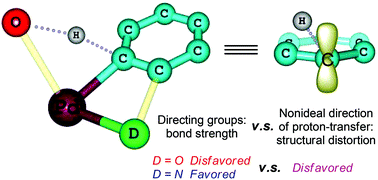Explicit roles of diverse directing groups in determining transition state energy and reaction exothermicity of C–H activation pathways†
Abstract
The aim of this paper was to explore, from a computational perspective, the explicit effects of diverse directing groups on the main kinetic and thermodynamic parameters for Pd(OAc)2-catalyzed aromatic C–H activation. As a prototype of undirected C–H activation reactions, palladation of benzene with Pd(OAc)2 has been investigated by using DFT calculations, which has revealed that the final palladated benzene is evidently unstable by ca. 7.1 kcal mol−1 in free-energy with respect to the initial materials, though the proton-transfer barrier is estimated to be merely 21.5 kcal mol−1. Then we performed a series of DFT characterization studies on the directed C–H activation pathway using 16 selected directing group systems. Comparing with the data of benzene and Pd(OAc)2, 7 of the 16 studied systems (Type A) were found to stabilize the final palladacycle yet increase the proton-transfer activation barrier, and the remaining 9 (Type B) could strongly stabilize the final palladacycle but have a minor effect on the proton-transfer activation free-energy barrier, indicating that the mediation of the directing group might not necessarily lower the free-energy barrier of C–H activation. Lastly, the main structure factors, in determining these variations of key energetic parameters, have been discussed in great detail.


 Please wait while we load your content...
Please wait while we load your content...